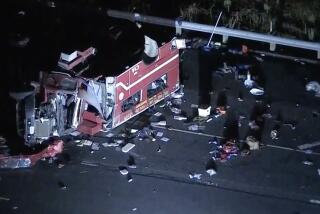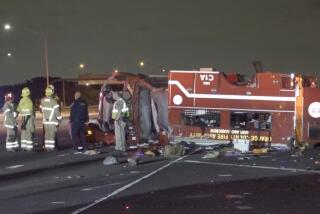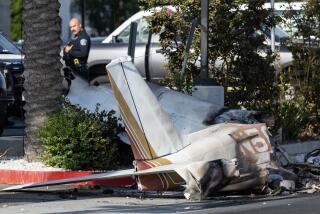Copter Crash Survivable, Report Says
Two paramedics killed in the 1998 crash of a Los Angeles Fire Department helicopter in Griffith Park might have survived if they had been provided appropriate shoulder restraints and helmets, according to a federal report.
Four people died in the accident, including 11-year-old Norma Vides-Anaya, who was being airlifted from a traffic accident in Sun Valley to Children’s Hospital when the helicopter crashed.
A report drafted by the National Transportation Safety Board and released Thursday by the Los Angeles Fire Department confirmed earlier city and federal findings that a tail rotor separated from the aircraft in flight “due to a fatigue fracture in the yoke” that secured the rotor blade.
A separate NTSB report that is not yet complete will address the possible causes of the fatigue fracture, officials said Thursday.
Ken Buzzell, president of the union representing firefighters and paramedics, said the draft report clearly concludes the city could have done more to prevent the deaths.
“The NTSB says this crash was survivable,” Buzzell said. “I think they probably would have been hurt, but would they have gotten killed? It doesn’t appear so.”
The draft report concluded that city policy then and now prohibits pilots from transporting crew members and paramedics without helmets, but said the paramedics who died, Michael Butler and Eric Reiner, were not provided helmets for the March 23, 1998, crash of helicopter Fire 3. And while lap seat belts were available, it was not clear whether they were used by all of the crew members at the time of the accident.
The report said the area of the copter where the paramedics and two other crew members were sitting was not fitted with shoulder harnesses. The copter was built before 1992, when the Federal Aviation Administration required all new aircraft to have shoulder restraints, according to the report.
Based on input from experts, including the private Head Protection Research Laboratory, the report stated that different equipment might have resulted in a different outcome for the two paramedics.
“In one case, the use of an appropriate restraint system would have allowed survival. In the other case, use of an appropriate restraint system and a helmet would have made survival highly probable,” the report said.
Pilot Steven L. Robinson, who survived, was wearing a helmet supplied by the city that was not recommended for helicopter flights, according to the report. The headgear “provided minimal crash impact resistance. . . . Due to its design, the impact energy was essentially without attenuation and contributed to the pilot’s skull fractures and brain injury,” according to the report.
The NTSB initially released the report over the Internet earlier this year, then withdrew it after complaints that sections dealing with design specifications disclosed proprietary information.
Fire Chief William Bamattre said Thursday that he briefed the Fire Commission in a closed-door meeting last month on the NTSB draft of the report.
Fire Department officials said their own post-accident internal review had pointed up the need for better restraint equipment on city helicopters. Shoulder restraints and helmets have been purchased and provided for all aircraft, according to the department. Bamattre said the fact that two people survived the crash means it was survivable, but said it is questionable whether shoulder harnesses would have made a difference, given that the lap belt anchors failed.
“If those lap belts came apart, than the four-point restraint system would have come apart,” Bamattre said.
While the report does not present any conclusions on why the tail rotor failed, it stated that during one inspection, the Fire Department did not tie down aircraft properly to protect the tail sections from stress caused by wind and other aircraft.
Fire Department officials said it is their routine practice to tie down helicopters.
More to Read
Sign up for Essential California
The most important California stories and recommendations in your inbox every morning.
You may occasionally receive promotional content from the Los Angeles Times.











